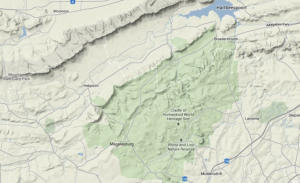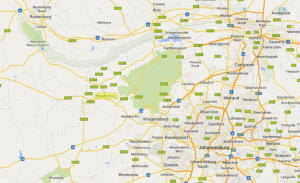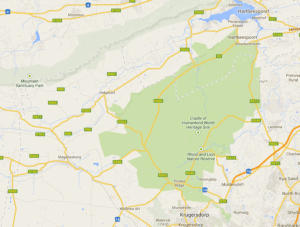









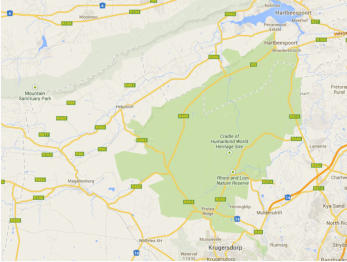
History
The history of the Magaliesberg region is long and varied.
The earliest evidence of man in the region can be traced back some 2.5 to 3 million years
to the first hominid descendants of modern man.
More recently the region saw the influx of the Tswana (Kwena), the Zulu (Matabele nation),
the Boer Trek from Natal and the British.
This was followed by the war between the “White Tribes” the Boer war in 1899
Early man...
Recent history...
Maps
Included in this section are maps of the Gauteng region showing Magaliesburg
in relation to Pretoria and Johannesburg as well as more detailed maps of the
Magaliesberg.
more...
Geology
The Magaliesberg is about 100 times older than Everest and has an
abundance of rich geological and geographic features to be seen
more...







Early man in the Magaliesberg
“Mrs Ples” is the nickname for the
perfect parts of a fossilized skull
found at Sterkfontein Caves,
about 20 minutes drive from
Magaliesburg. This skull has
shown that man was in the
Magaliesberg region as long as 2
million years ago.
Mrs Ples, who is probably in fact
an adolescent male, was
discovered by Dr Robert Broom in
1947 at Sterkfontein Caves. It is
believed to be a distant relative of
all humankind. It has a small
cranium and unquestionably stood upright, like humans.
Mrs Ples is in the genus Australopithecus africanus and is believed to be between
2.5 and 3 million years old.
Many people have lived in the region over hundreds of thousands of years,
leaving evidence of different lifestyles, cultures and technologies from primitive
societies through to the Late Iron Age and beyond.
The tribes of the descendants of the earliest proto-hominids had free reign in the
tranquil valley. They fished and hunted the vast herds of animals with tools made
initially from stone and later forged from iron. Man lived in total harmony with
nature, which flourished in abundance in the greater Magaliesburg Area for the
two million years of his development.
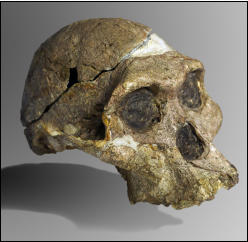
![Close [x]](index_htm_files/close.png)

1800's
Tswana migration
The Twana peoples ancestors migrated through Zambia and Botswana and settled in groups all over the highveld.
A group of Kwena people moved into the Magaliesberg and the Kwena chief at the time, Modimosana, divided his chiefdom among his four sons, who
called their groups Kwena Magopa, Kwena Maake, Kwena Matlahaku and Kwena Mmatau. The Kwena Mmatau, were particularly successful and
became the dominant group.
By 1800 they had constructed stone walled villages all along the southern slopes straddling the mountain passes that early ivory traders used on their
way to the Cape. These traders and other travelers called the mountains Cashan after Kgwashwane, the powerful chief of the Kwena Mmatau and it
remained that name until about 1840
1822 The Zulu invasion
Around 1822, Shaka, leader of the Zulu nation, sent his favourite captain, Mzilikazi to subdue the Sotho tribes
in the area. After conquering the Sotho tribes, Mzilikazi decided to break away from Shaka and the Zulu tribe
and create his own clan (AmaKhumalo, or elephant clan).
In 1824 the AmaKhumalo, fearing an attack from Shaka, fled north of the Vaal River and settled in the
Magaliesberg regions. Mzilikazi’s impis left behind them a trail of destruction while consolidating the Matabele
nation. Neighbouring tribes were living in trees in fear of their lives.
Boer trekkers.
After a number of Boer trek parties had been slaughtered by Mzilikazi’s impis, the Boers, led by Hendrik
Potgieter and Gert (Gerrit) Maritz, drove them north across the Limpopo River where Mzilikazi later
established his kingdom of Bulawayo in Zimbabwe.
The Boers settled in the valleys of the Magaliesberg and turned it into some of the most productive farmland in South Africa.
Second Boer War (South African War)
In October 1899, war broke out between the two ‘white tribes, the British and the Boer republics of
Transvaal and Orange Free State. Within a year many lives were lost in the fighting in the
Magaliesberg valleys, and in many of the deep gorges and high ridges along the mountain side.
The Boers who were very familiar with the mountains, used secret pathways to cross the mountains
and launch guerrilla attacks on the British soldiers.
Occupation of the Magaliesberg was of great importance to the Boer and English forces, especially
routes between Pretoria and Rustenburg that crossed the Magaliesberg mountains through,
Silkaatsnek and Kommandonek. Great battles were fought and lives were lost at Buffelspoort,
Nooitgedacht, Kommando Nek and Olifantsnek.
The mountains were a severe testing of military skills and the Magaliesberg war was dominated by
Boer leaders like De la Rey, De Wet, Beyers, Smuts and Kemp, who were experts in guerrilla
leadership.
All over the area remnants of these
clashes can be seen. Many forts and blockhouses were built at strategic points in the
mountains and some can still be seen today, the most prominent being the fort
overlooking Kommando Nek and the Hartebeespoort Dam
Although many of the farms lay in ruins after the second Anglo-Boer war, the natural
beauty of the Magaliesberg remained unscarred and breathtaking as it is today.

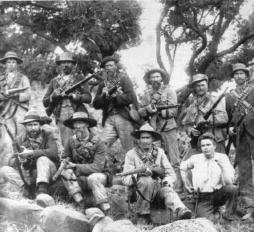
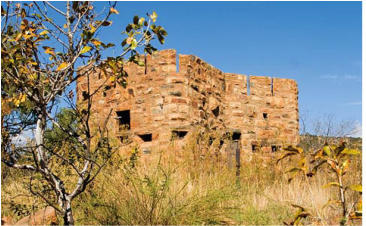


![Close [x]](index_htm_files/close.png)

The Magaliesberg Mountain Range The Magaliesberg Mountain Range (historically also known as Macalisberg or the Cashan
The Magaliesberg Mountain Range (historically also known as Macalisberg or the Cashan Mountains) is a mountain range extending from Pretoria in the north of the Gauteng Province
Mountains) is a mountain range extending from Pretoria in the north of the Gauteng Province to a point south of Pilanesberg, in the North West Province. The highest point of the
to a point south of Pilanesberg, in the North West Province. The highest point of the Magaliesberg is reached at Nooitgedacht (1,852
Magaliesberg is reached at Nooitgedacht (1,852 metres).
The mountain range forms a natural barrier between
metres).
The mountain range forms a natural barrier between the lower lying Bushveld to the north and the cooler
the lower lying Bushveld to the north and the cooler Highveld to the south.
Highveld to the south. The Magaliesberg is about 100 times older than
The Magaliesberg is about 100 times older than Everest and was formed more than two billion years
Everest and was formed more than two billion years ago when seismic forces cracked the bed of
ago when seismic forces cracked the bed of what was then an inland sea and tilted it
what was then an inland sea and tilted it skyward. Molten magma pumped into
skyward. Molten magma pumped into fissures and burned deep kloofs in the rock.
fissures and burned deep kloofs in the rock. Over millions of years the jagged peaks of
Over millions of years the jagged peaks of the tilted seabed were scoured by a
the tilted seabed were scoured by a continental ice sheet, then buried in swamp,
continental ice sheet, then buried in swamp, smothered under desert sands and finally capped with volcanic lava.
smothered under desert sands and finally capped with volcanic lava. Sixty million years ago the covering began to weather away and the mountains re-
Sixty million years ago the covering began to weather away and the mountains re- emerged to become the cliffs, gentle slopes, secretive kloofs and the tumbling
emerged to become the cliffs, gentle slopes, secretive kloofs and the tumbling streams of today.
streams of today.
 The Magaliesberg Mountain Range (historically also known as Macalisberg or the Cashan
The Magaliesberg Mountain Range (historically also known as Macalisberg or the Cashan Mountains) is a mountain range extending from Pretoria in the north of the Gauteng Province
Mountains) is a mountain range extending from Pretoria in the north of the Gauteng Province to a point south of Pilanesberg, in the North West Province. The highest point of the
to a point south of Pilanesberg, in the North West Province. The highest point of the Magaliesberg is reached at Nooitgedacht (1,852
Magaliesberg is reached at Nooitgedacht (1,852 metres).
The mountain range forms a natural barrier between
metres).
The mountain range forms a natural barrier between the lower lying Bushveld to the north and the cooler
the lower lying Bushveld to the north and the cooler Highveld to the south.
Highveld to the south. The Magaliesberg is about 100 times older than
The Magaliesberg is about 100 times older than Everest and was formed more than two billion years
Everest and was formed more than two billion years ago when seismic forces cracked the bed of
ago when seismic forces cracked the bed of what was then an inland sea and tilted it
what was then an inland sea and tilted it skyward. Molten magma pumped into
skyward. Molten magma pumped into fissures and burned deep kloofs in the rock.
fissures and burned deep kloofs in the rock. Over millions of years the jagged peaks of
Over millions of years the jagged peaks of the tilted seabed were scoured by a
the tilted seabed were scoured by a continental ice sheet, then buried in swamp,
continental ice sheet, then buried in swamp, smothered under desert sands and finally capped with volcanic lava.
smothered under desert sands and finally capped with volcanic lava. Sixty million years ago the covering began to weather away and the mountains re-
Sixty million years ago the covering began to weather away and the mountains re- emerged to become the cliffs, gentle slopes, secretive kloofs and the tumbling
emerged to become the cliffs, gentle slopes, secretive kloofs and the tumbling streams of today.
streams of today.
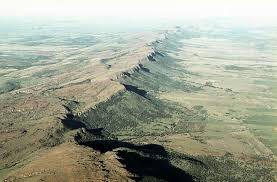
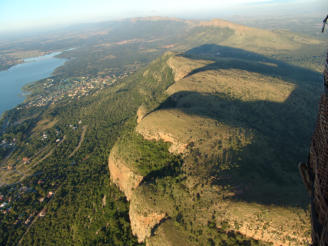

![Close [x]](index_htm_files/close.png)










